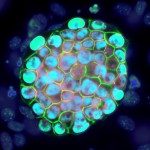Lien vers Pubmed [PMID] – 16789828
PLoS Genet. 2006 Jun;2(6):e94
A critical step in X-chromosome inactivation (XCI), which results in the dosage compensation of X-linked gene expression in mammals, is the coating of the presumptive inactive X chromosome by the large noncoding Xist RNA, which then leads to the recruitment of other factors essential for the heterochromatinisation of the inactive X and its transcriptional silencing. In an approach aimed at identifying genes implicated in the X-inactivation process by comparative transcriptional profiling of female and male mouse gastrula, we identified the Eif1 gene involved in translation initiation and RNA degradation. We show here that female embryonic stem cell lines, silenced by RNA interference for the Eif1 gene, are unable to form Xist RNA domains upon differentiation and fail to undergo X-inactivation. To probe further an effect involving RNA degradation pathways, the inhibition by RNA interference of Rent1, a factor essential for nonsense-mediated decay and Exosc10, a specific nuclear component of the exosome, was analysed and shown to similarly impair Xist upregulation and XCI. In Eif1-, Rent1-, and Exosc10-interfered clones, Xist spliced form(s) are strongly downregulated, while the levels of unspliced form(s) of Xist and the stability of Xist RNA remain comparable to that of the control cell lines. Our data suggests a role for mRNA nuclear degradation pathways in the critical regulation of spliced Xist mRNA levels and the onset of the X-inactivation process.
